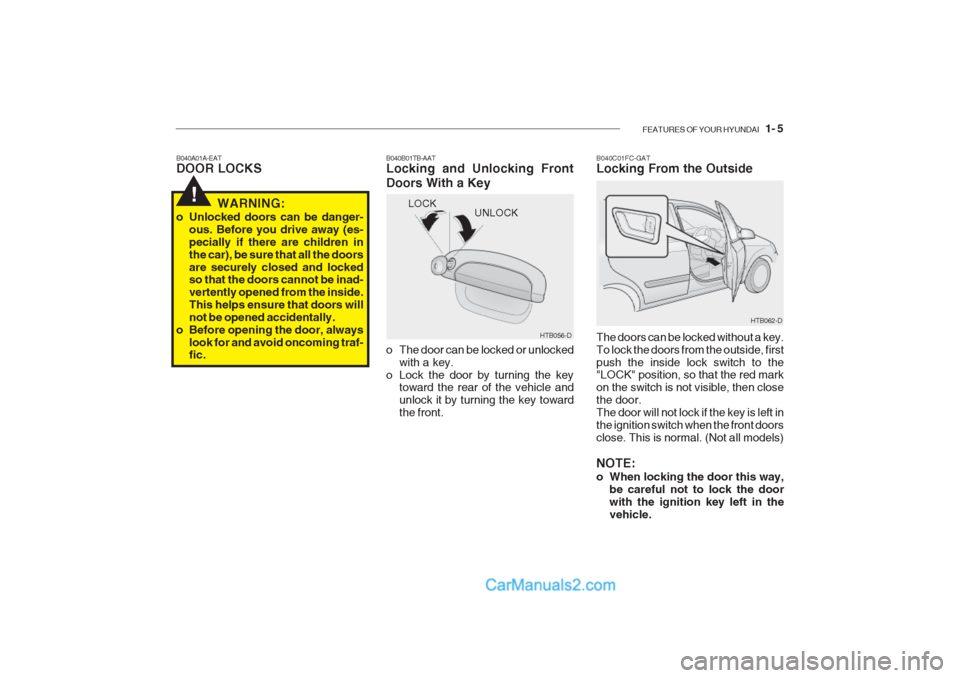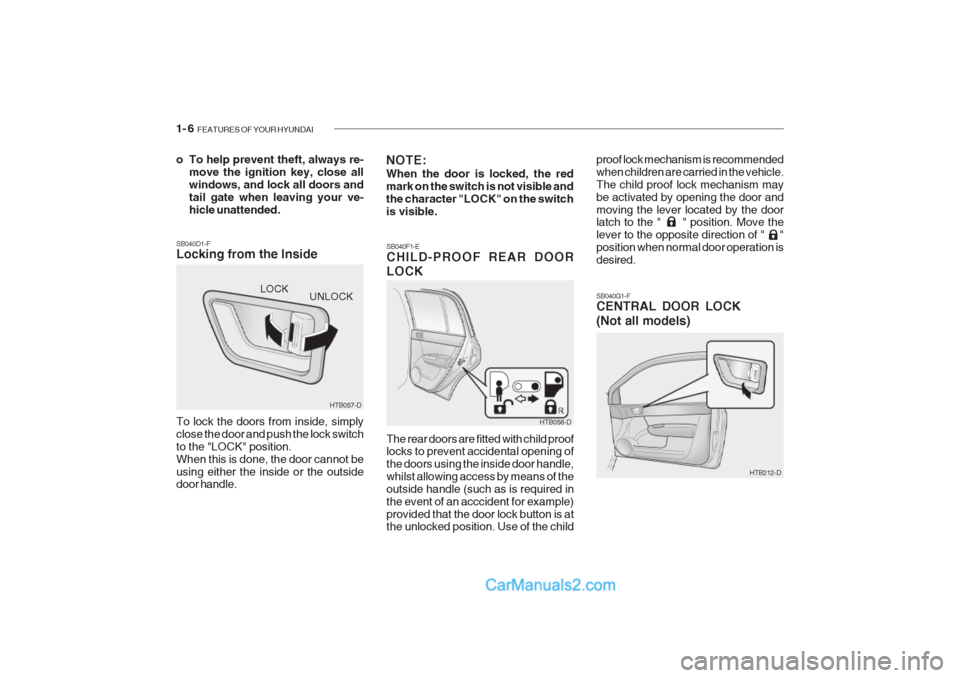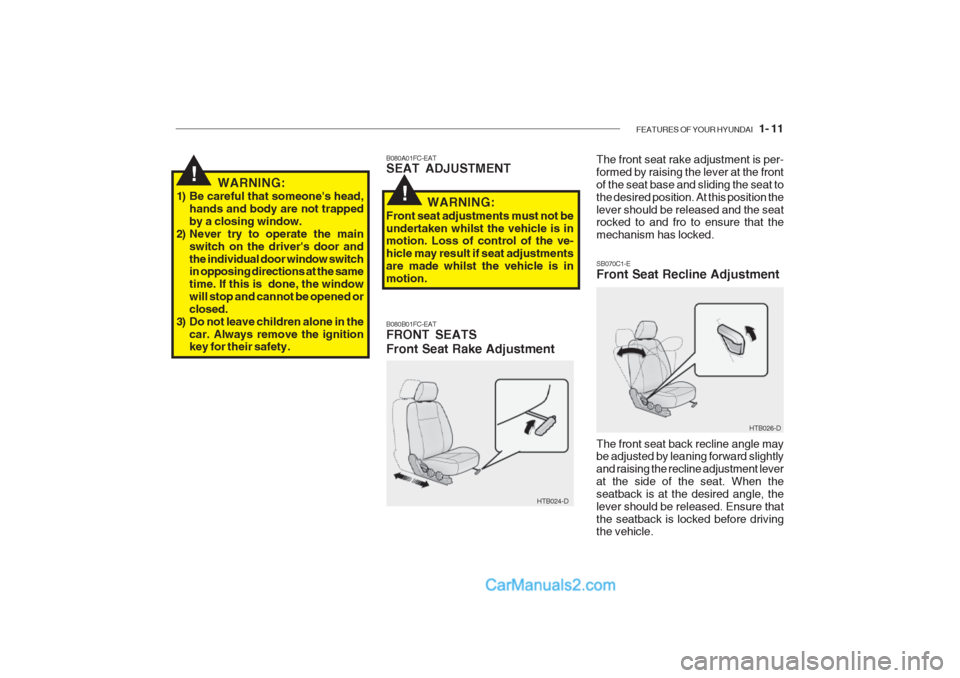2002 Hyundai Getz child lock
[x] Cancel search: child lockPage 249 of 428

FEATURES OF YOUR HYUNDAI 1- 5
B040A01A-EAT DOOR LOCKS B040B01TB-AATLocking and Unlocking Front Doors With a Key
!WARNING:
o Unlocked doors can be danger- ous. Before you drive away (es- pecially if there are children inthe car), be sure that all the doorsare securely closed and locked so that the doors cannot be inad- vertently opened from the inside.This helps ensure that doors willnot be opened accidentally.
o Before opening the door, always
look for and avoid oncoming traf- fic. o The door can be locked or unlocked
with a key.
o Lock the door by turning the key toward the rear of the vehicle and unlock it by turning the key towardthe front. B040C01FC-GAT Locking From the Outside The doors can be locked without a key. To lock the doors from the outside, firstpush the inside lock switch to the "LOCK" position, so that the red mark on the switch is not visible, then closethe door.The door will not lock if the key is left inthe ignition switch when the front doorsclose. This is normal. (Not all models) NOTE:
o When locking the door this way,
be careful not to lock the door with the ignition key left in thevehicle.UNLOCK
HTB056-D
LOCK
HTB062-D
Page 250 of 428

1- 6 FEATURES OF YOUR HYUNDAI
SB040G1-F CENTRAL DOOR LOCK (Not all models)
SB040D1-F Locking from the Inside To lock the doors from inside, simply close the door and push the lock switchto the "LOCK" position.When this is done, the door cannot beusing either the inside or the outside door handle. SB040F1-ECHILD-PROOF REAR DOOR LOCK The rear doors are fitted with child proof locks to prevent accidental opening of the doors using the inside door handle,whilst allowing access by means of theoutside handle (such as is required inthe event of an acccident for example)provided that the door lock button is at the unlocked position. Use of the child
o To help prevent theft, always re-
move the ignition key, close all windows, and lock all doors andtail gate when leaving your ve-hicle unattended.
NOTE: When the door is locked, the red mark on the switch is not visible andthe character "LOCK" on the switchis visible. proof lock mechanism is recommendedwhen children are carried in the vehicle.The child proof lock mechanism maybe activated by opening the door andmoving the lever located by the door latch to the " " position. Move the lever to the opposite direction of " "position when normal door operation isdesired.
HTB057-D
UNLOCK
LOCK
HTB058-D
HTB212-D
Page 255 of 428

FEATURES OF YOUR HYUNDAI 1- 11
HTB026-D
HTB024-D
B080A01FC-EAT SEAT ADJUSTMENT B080B01FC-EAT FRONT SEATS Front Seat Rake Adjustment
The front seat rake adjustment is per- formed by raising the lever at the frontof the seat base and sliding the seat tothe desired position. At this position thelever should be released and the seat rocked to and fro to ensure that the mechanism has locked.
!WARNING:
Front seat adjustments must not be undertaken whilst the vehicle is in motion. Loss of control of the ve- hicle may result if seat adjustmentsare made whilst the vehicle is inmotion. SB070C1-E Front Seat Recline Adjustment
WARNING:
1) Be careful that someone's head, hands and body are not trapped by a closing window.
2) Never try to operate the main switch on the driver's door andthe individual door window switch in opposing directions at the same time. If this is done, the windowwill stop and cannot be opened orclosed.
3) Do not leave children alone in the
car. Always remove the ignition key for their safety.
!
The front seat back recline angle may be adjusted by leaning forward slightly and raising the recline adjustment leverat the side of the seat. When theseatback is at the desired angle, thelever should be released. Ensure thatthe seatback is locked before driving the vehicle.
Page 265 of 428

FEATURES OF YOUR HYUNDAI 1- 21
B220C01Y-DAT To Release the Seat Belt When you want to release the seat belt, press the button in the locking buckle. HTB191
WARNING:
The centre belt latching mechanismis different from those for the rear seat shoulder belts. When fasteningthe rear seat shoulder belts or therear seat centre belt, make sure theyare inserted into the correct bucklesto obtain maximum protection from the seat belt system and assure proper operation.
!
B230A03A-EAT CHILD RESTRAINT SYSTEM Children riding in the car should sit in the rear seat and must always be prop-erly restrained to minimize the risk ofinjury in an accident, sudden stop orsudden manoeuvre. According to acci- dent statistics, children are safer when properly restrained in the rear seatsthan in the front seat. Larger childrenshould use one of the seat belts pro-vided.You are required by law to use safety restraints for children. If small children ride in your vehicle you must put themin a child restraint system (safety seat).Children could be injured or killed in acrash if their restraints are not properlysecured. For small children and babies, a child seat or infant seat must be used. Before buying a particular child restraintsystem, make sure it fits your car andseat belts, and fits your child. Follow allthe instructions provided by the manu-facturer when installing the child re- straint system. WARNING:
o A child restraint system must be placed in the rear seat. Never in- stall a child or infant seat on thefront passenger's seat.Should an accident occur andcause the passenger side airbag to deploy, it could severely injure or kill an infant or child seated inan infant or child seat. Thus, onlyuse a child restraint in the rearseat of your vehicle.
o Since a safety belt or child re- straint system can become veryhot if it is left in a closed vehicle,be sure to check the seat coverand buckles before placing a childthere.
o When the child restraint system is not in use, store it in the trunk orfasten it with a safety belt so that itwill not be thrown forward in thecase of a sudden stop or an acci-dent.
o Children who are too large to be in a child restraint should sit in therear seat and be restrained withthe available lap/shoulder belts.
!
Page 267 of 428

FEATURES OF YOUR HYUNDAI 1- 23
WARNING:
Do not install any child restraint sys- tem in the front passenger seat. Should an accident occur and cause the passenger side airbag to deploy,it could severely injure or kill aninfant or child seated in an infant orchild seat. Therefore, only use a childrestraint system in the rear seat of your vehicle.
If you need to tighten the belt, pull more webbing toward the retractor. When youunbuckle the seat belt and allow it toretract, the retractor will automaticallyrevert back to its normal seated pas- senger emergency locking usage con- dition. NOTE:
o Before installing the child restraint
system, read the instructions sup- plied by the child restraint systemmanufacturer.
o If the seat belt does not operate as
described, have the systemchecked immediately by your au-thorized Hyundai dealer.!
B230B01TB
B230B02A-GAT Using a Child Restraint System with "Tether Anchorage" Sys- tem For small children and babies, the use of a child seat or infant seat is strongly recommended. This child seat or infant seat should be of appropriate size forthe child and should be installed inaccordance with the manufacturer's in-structions. It is further recommendedthat the seat be placed in the vehicle's rear seat since this can make an impor- tant contribution to safety. Your vehicleis provided with three child restrainthook holders for installing the child seator infant seat. Spacer (10mm), Child Restraint Hook Holder
Holder Bolt (5/16"-30 mm) Washer, Conical Spring Holder, Child Restraint Hook
Retainer Washer B230E02FC-GAT Securing a Child Restraint Sys- tem with "Tether Anchorage" System Three child restraint hook holders are located on the vertical back panel.(behind rear bumper bar)
1. Route the child restraint seat strap
over the seatback. For vehicles with adjustable head- rests, route the tether strap underthe headrest and between the head-rest posts, otherwise route the tetherstrap over the top of the seatback.
Page 425 of 428

10- 2 INDEX
A AIR BAG ................................................................... 1-29
AIR CONDITIONING SWITCH .................................1-74
AIR CONDITIONING SYSTEM MAINTENANCE ..... 6-19
AIR CLEANER FILTER ............................................. 6-14
ANTENNA ................................................................. 1-81
ANTI-LOCK BRAKE SYSTEM .................................. 2-13
ANTI-THEFT ALARM SYSTEM .................................. 1-7
ASHTRAY ................................................................. 1-52
AUTO FUEL CUT SW ITCH...................................... 1-66
AUTOMATIC TRANSAXLE ......................................... 2-9AUTOMATIC TRANSAXLE FLUID ...........................6-16
BBATTERY MAINTENANCE ......................................6-25
BEFORE STARTING THE ENGINE ...........................2-3
BONNET RE LEASE.................................................. 1-60
BRAKE PEDAL FREEPLAY .....................................6-22
BRAKE SYSTEM CHECKING ..................................6-18
CCARE OF DISC ......................................................... 1-79
CARE OF SEAT BELTS .... .......................................1-17
CARGO AREA COVER ............................................ 1-63
CATALYTIC CONVERTOR OPERATING PRECAUTIONS ...................................................... 7-3
CENTRAL DOOR LOCKS .......................................... 1-5
CHANGING A FLAT TYRE ......................................... 3-6 CHILD-PROOF REAR DOOR
LOCK .......................... 1-5
CHILD RESTRAINT SYSTEM ..................................1-21
CIGAR LIGHTER ...................................................... 1-51
CLUTCH PEDAL FR EEPLAY................................... 6-22
COMBINATION IGNITION SWITCH AND STEERING LOCK ................................................... 2-3
CONSOLE TRAY ...................................................... 1-52
COOLANT TEMPERATURE GAUGE .......................1-42
DDAILY OPERATING CHECKS .................................... 6-6
DIGITAL CLOCK ....................................................... 1-51
DOOR LOCK S ............................................................ 1-5
DOOR WINDOWS .................................................... 1-10
DRINK HOLDER ....................................................... 1-52
DRIVE BELTS ........................................................... 6-23
DRIVING FOR ECONOMY .......................................2-14
EEFFECTIVE BRA KING............................................. 2-13
ELECTRIC COOLING FANS ....................................6-25
EMERGENCY TOWING .... .......................................3-12
EMISSION CONTROL SYSTEM ................................ 7-2
ENGINE COMPARTMENT .................... ..................... 6-2
ENGINE COOLANT CHECKING AND REPLACING ......................................................... 6-10
ENGINE OIL AND FILTER REPLACEMENT .............. 6-9
ENGINE OIL CONSUMPTION ................................... 6-8